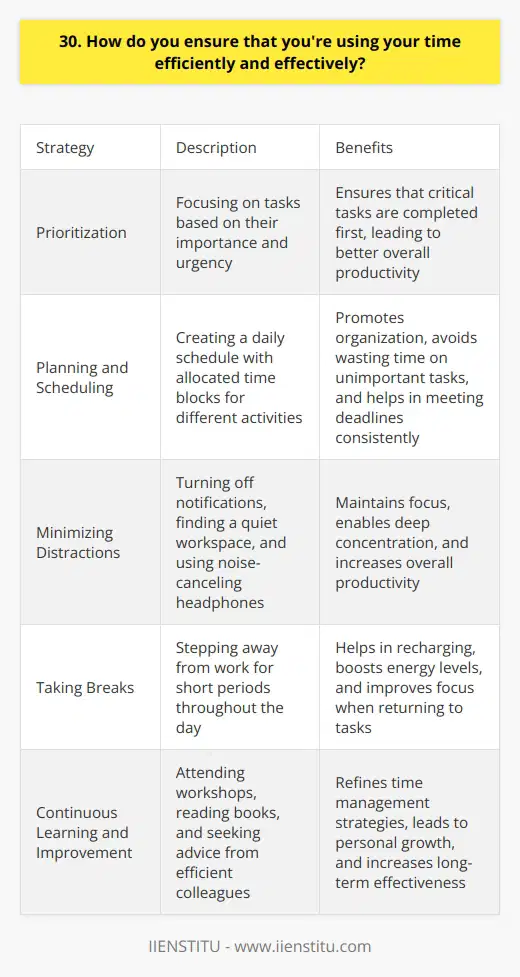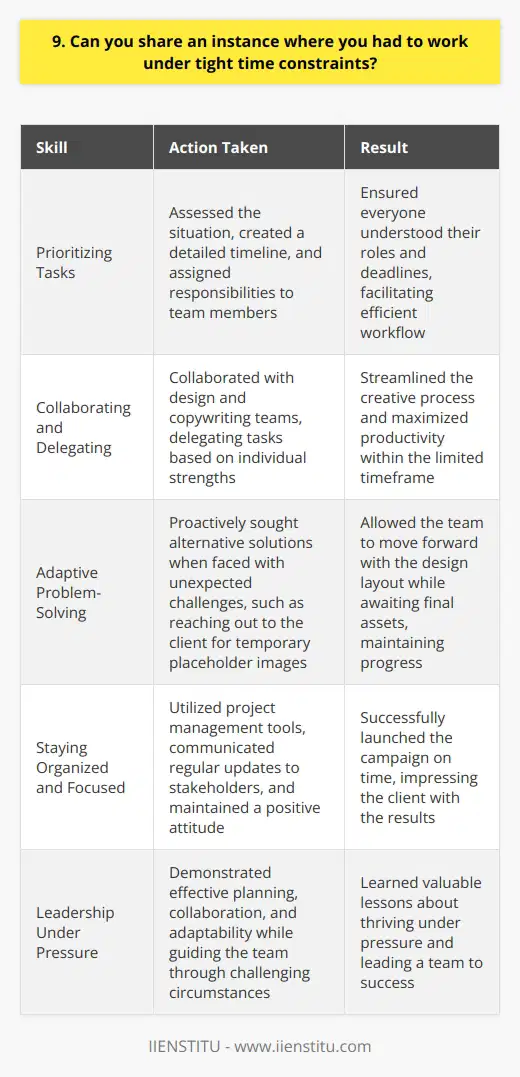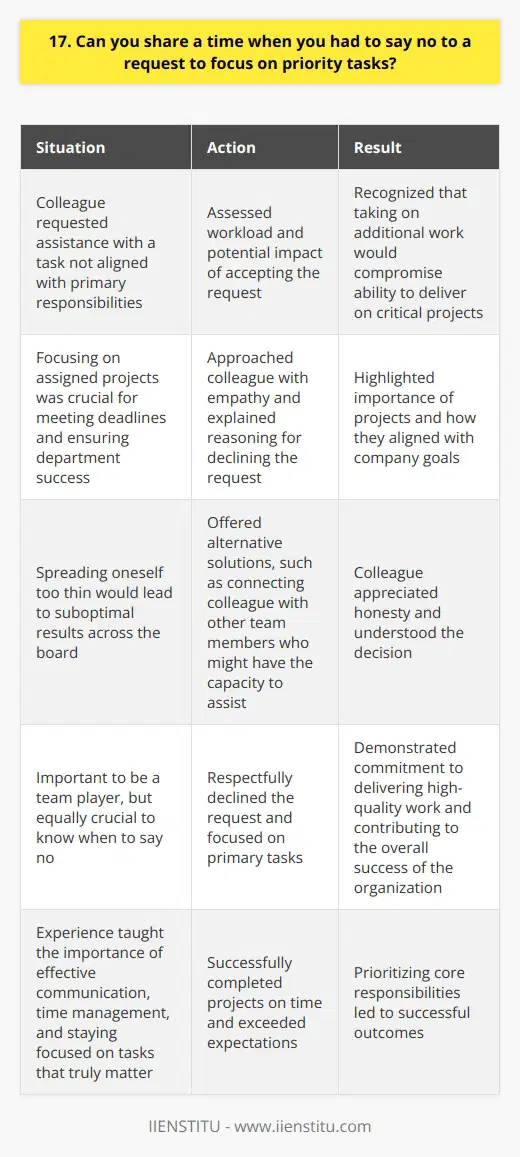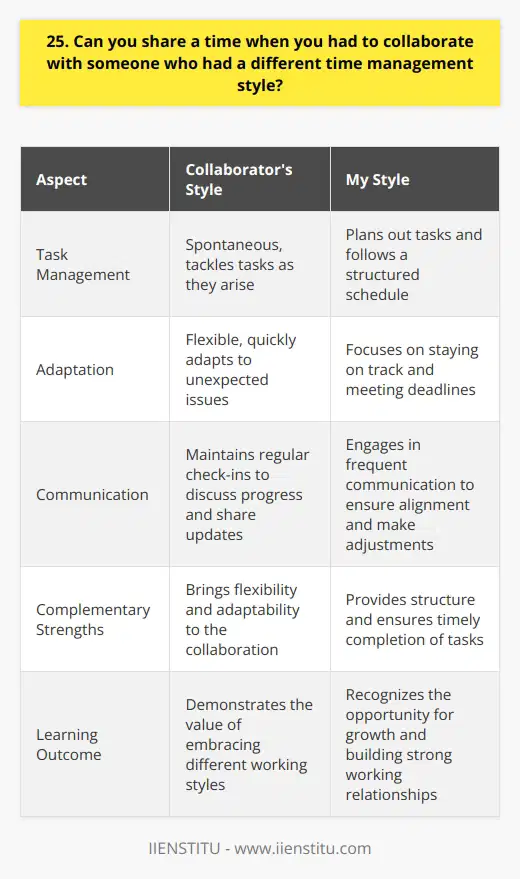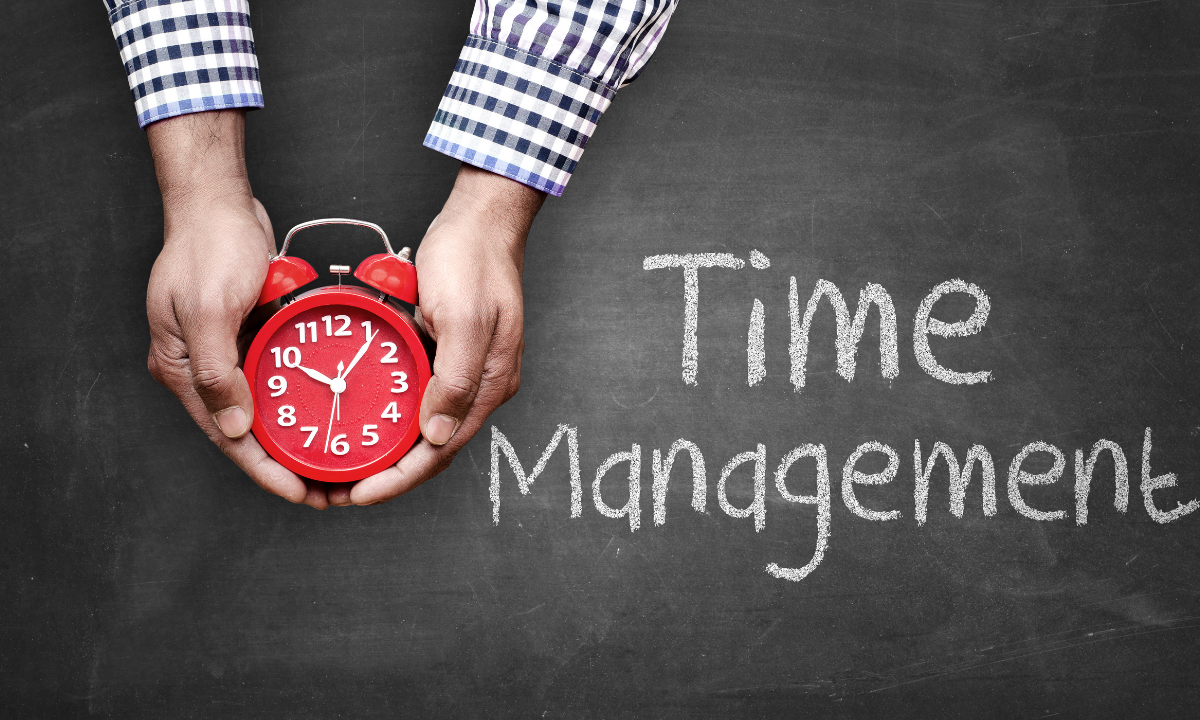
One of the common queries you might face during a job interview is, "Can You Share a Time Management Challenge You Overcame?" Delving into the question's intent will shed light on how you should structure your responses.
Related Course: Time Management Training Course
This query isn't asked merely to confound you. It serves a significant purpose. Interviewers ask this question to unearth potential gems about your problem-solving skills, professional resilience, and your ability to confront demanding situations, particularly concerning time management.
They desperately want to size up your reactions to stressful, time-crunched conditions because such occurrences are commonplace in today’s quick-paced work world.
By describing an experience where you successfully surmounted a past time management issue, they can gauge if you possess the vital skills to handle similar challenges in the future.
The Purpose of the Question: Can You Share a Time Management Challenge You Overcame?
The purpose of the question "Can You Share a Time Management Challenge You Overcame?" primarily is to assess your ability to efficiently manage time, a core competency in today’s dynamic work landscape. Every project, every role, every job involves deadlines.
How effectively one juggles multiple tasks within looming deadlines is a crucial skill separates the ordinary performers from the extraordinary. When you describe a past scenario where you overcame a time management challenge, an employer gauges your organizational strategies, decision-making abilities, resilience, ability to prioritize tasks, problem-solving tactics, and even, work ethic and persistence.
At what interview level is it asked?
Interview Question: Describe a High-Stress Situation at Work
Interview Question: How Do Time Management Techniques Vary for You Weekdays vs. Weekends?
Interview Question: Describe a Failed Digital Marketing Attempt
This question is generally asked during middle to late stages of the interview process when the hiring authority proactively starts evaluating your softer skills and behavioral nuances.
This is often the stage where you have moved beyond assessing your basic competencies and technical skills. Instead, they are now more interested in understanding your strategic skills, problem-solving abilities, and how you juggle tasks under high-pressure environments.
What kind of answer is expected from the Candidate?
When interviewers pop the question about a time management challenge you overcame, they're not merely looking for a story. They are looking forward to hearing how you tackled the situation, showcasing your problem-solving skills pragmatically.
The methodology you employed, the time management strategies you adopted, how you prioritized your tasks, and the ultimate results achieved form your coherent narrative's crux.
Use the STAR method (Situation, Task, Action, Result) to structure your answer. Begin by describing the situation, define the time management challenge, elucidate the actions you undertook, and conclude with the successful results achieved.
A bad answer would focus solely on the challenge, making you come off as someone who gets easily overwhelmed. An exceptional response, however, would confidently narrate the time-related obstacle, but more importantly, underline the proactive measures undertaken to overcome it decisively.
Possible Answers to Consider
Remember, when confronted with the query, "Can You Share a Time Management Challenge You Overcame?", there is no fixed right answer. The perfect reply depends on your past experiences and how you've learned from them.
Consider highlighting a story where you faced a fast-approaching deadline or multiple conflicting tasks and how you successfully navigated through them. Ensure your answer transparently communicates your problem-solving skills, leadership abilities (if you led a team), and determination to meet deadlines despite all odds.
Related Course: Leadership Training Course
To round up, handling the answer to "Can you share a time management challenge you overcame?" is about maintaining a fine balance. Don't overstate the criticality of your challenge to look like a victim. Instead, stress the strategies, decisiveness, and problem-solving skills you used to overcome such a challenge.
This response will portray you as a resilient, reliable, and ready-for-action professional, endearing you to the hiring manager. The question might seem challenging, but it's your golden opportunity to pitch your problem-solving abilities and work ethic, which are crucial to excel in today’s dynamic work environment.
Strategies Implemented to Overcome Time Management Challenges
Personal Schedules vs. Professional Deadlines: Case Studies on Time Management
Effective Time Management Tools and Techniques Utilized for Problem-Solving
Similar interview questions:
Could you narrate an instance where you surmounted a difficulty involving the management of time?
Have you ever faced a situation where your time management skills were tested and how did you overcome it?
Can you describe an experience where you had to find a solution to a time management problem?
In your experience, what was the most challenging time management issue that you successfully resolved?
Can you give an example of a challenging scenario where you had to manage your time effectively?
Do you recall a period where you had to tackle a time management issue and how did you resolve it?
What is your most memorable experience in overcoming a time management challenge?
Have there been instances where you had to strategize to overcome a challenge regarding time management?
Can you share a success story pertaining to a time management problem that you needed to solve?
Have you ever been put in a situation where managing time was difficult and how did you handle it?

Frequently Asked Questions
1. How do you prioritize tasks when you have multiple deadlines?
When faced with multiple deadlines, I prioritize tasks based on their urgency and importance. I assess each task's due date and its impact on the company's goals.
Communicate with Stakeholders
I communicate with my manager and colleagues to understand the priorities from their perspective. This helps me align my tasks with the team's objectives.
Create a To-Do List
I make a to-do list, ranking tasks from most to least urgent. I break down complex projects into manageable steps.
Use Time Blocking
I allocate specific time blocks for each task, ensuring I have enough time to complete them. This keeps me focused and prevents procrastination.
Be Flexible and Adaptable
I remain flexible and ready to adjust my priorities if new urgent tasks arise. I'm comfortable with change and can adapt quickly.
In my previous role, I once had three critical deadlines on the same day. By prioritizing based on importance and communicating with my team, I successfully completed all tasks on time. This experience taught me the value of effective prioritization and time management.
I believe that by staying organized, communicating openly, and being adaptable, I can efficiently manage multiple deadlines and deliver high-quality work.

2. Can you describe a situation where you had to manage a heavy workload?
In my previous role as a project manager, I often faced heavy workloads with tight deadlines. One particularly challenging situation involved managing multiple projects simultaneously, each with its own unique requirements and stakeholders.
Prioritizing Tasks and Delegating Responsibilities
To effectively manage the heavy workload, I first prioritized tasks based on urgency and importance. I created a detailed project plan, breaking down each project into smaller, manageable tasks. I then delegated responsibilities to my team members according to their skills and expertise, ensuring a balanced distribution of work.
Effective Communication and Collaboration
Regular communication with my team and stakeholders was crucial. I scheduled daily stand-up meetings to discuss progress, identify roadblocks, and brainstorm solutions. I also maintained open lines of communication with clients to manage expectations and provide updates.
Utilizing Project Management Tools
To stay organized and on track, I utilized project management tools like Trello and Asana. These tools helped me create task lists, set deadlines, and monitor progress in real-time. They also facilitated collaboration among team members, ensuring everyone was on the same page.
Adapting to Changes and Overcoming Challenges
Throughout the projects, unexpected challenges arose, such as scope changes and resource constraints. I remained flexible and adaptable, adjusting plans as needed while still keeping the end goals in mind. I also sought guidance from my mentors and colleagues when faced with particularly complex issues.
By prioritizing tasks, delegating effectively, communicating regularly, and utilizing project management tools, I successfully managed the heavy workload and delivered all projects on time and within budget. This experience taught me the importance of staying organized, being proactive, and collaborating closely with my team to achieve our goals.
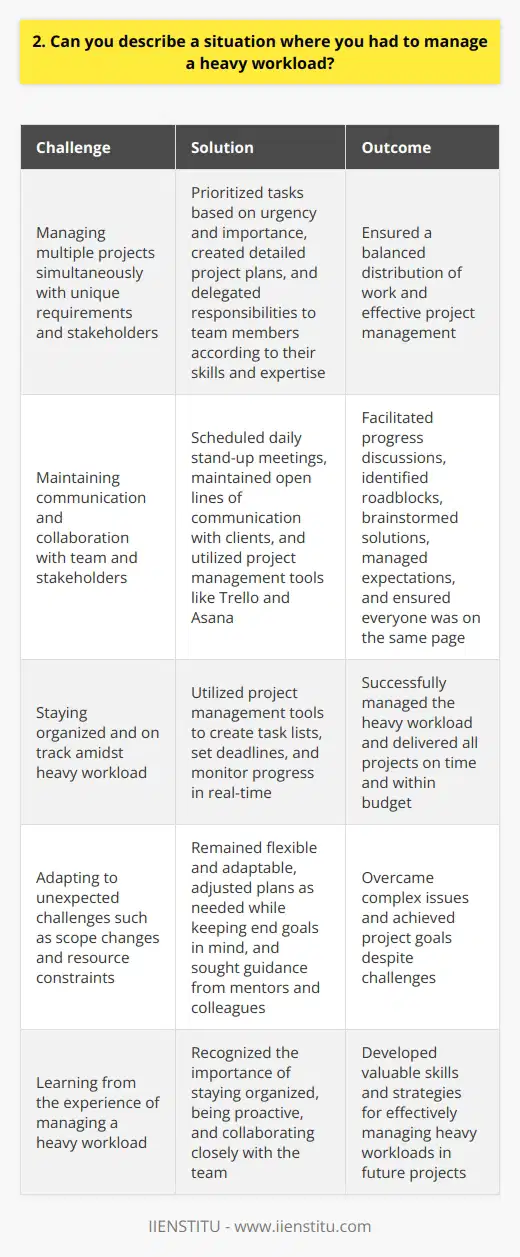
3. What strategies do you use to stay organized and focused?
I have developed several strategies over the years to stay organized and focused in my work. One key approach is to prioritize my tasks based on importance and urgency. This helps me tackle the most critical items first and manage my time effectively.
Leveraging Technology
I also leverage technology to keep myself on track. I use digital tools like calendar reminders, to-do lists, and project management software to ensure nothing slips through the cracks. These tools help me break down large projects into manageable chunks and monitor my progress.
Minimizing Distractions
To maintain focus, I try to minimize distractions in my workspace. I close unnecessary browser tabs, silence notifications on my phone, and communicate my availability to colleagues. When I need deep concentration, I sometimes use noise-canceling headphones or work in a quiet room.
Taking Breaks
Ironically, I find that taking regular breaks actually boosts my productivity and focus. Stepping away from my desk for a few minutes to stretch, grab a snack, or chat with a coworker helps me recharge and return to my tasks with fresh energy and perspective.
Continuously Improving
Finally, I'm always looking for ways to refine my organizational skills and workflows. I reflect on what's working well and what could be improved, and I'm open to trying new strategies and tools. Staying adaptive helps me stay on top of my responsibilities even as my role evolves.
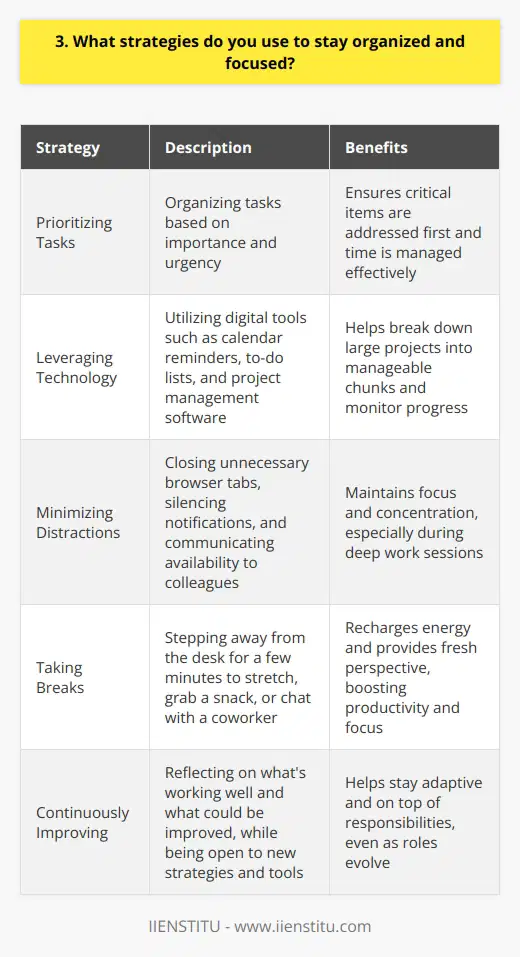
4. How do you handle interruptions or unexpected changes to your schedule?
I handle interruptions and unexpected changes to my schedule by staying flexible and adaptable. When faced with an interruption, I quickly assess the situation and determine the best course of action. If it's an urgent matter that requires immediate attention, I prioritize it and communicate any potential delays to my team or stakeholders.
Staying Organized
To minimize the impact of interruptions, I keep my work organized and maintain a clear understanding of my priorities. This allows me to easily switch between tasks and quickly get back on track after an interruption. I also make sure to document my progress and next steps, so I can easily resume where I left off.
Communicating Effectively
When unexpected changes occur, I proactively communicate with my team and stakeholders to ensure everyone is on the same page. I provide updates on how the changes impact our goals and timelines, and collaborate with others to adjust our plans accordingly. Clear communication helps minimize confusion and keeps everyone aligned.
Embracing Change
I view interruptions and changes as opportunities for growth and learning. Instead of getting frustrated or overwhelmed, I embrace the challenge and look for ways to adapt and improve. By maintaining a positive attitude and focusing on solutions, I can navigate unexpected situations with confidence and resilience.
Continuous Improvement
After dealing with an interruption or change, I take time to reflect on how I handled the situation. I consider what worked well and what I could have done differently, and use those insights to improve my approach in the future. By continuously learning and adapting, I become better equipped to handle unexpected challenges.
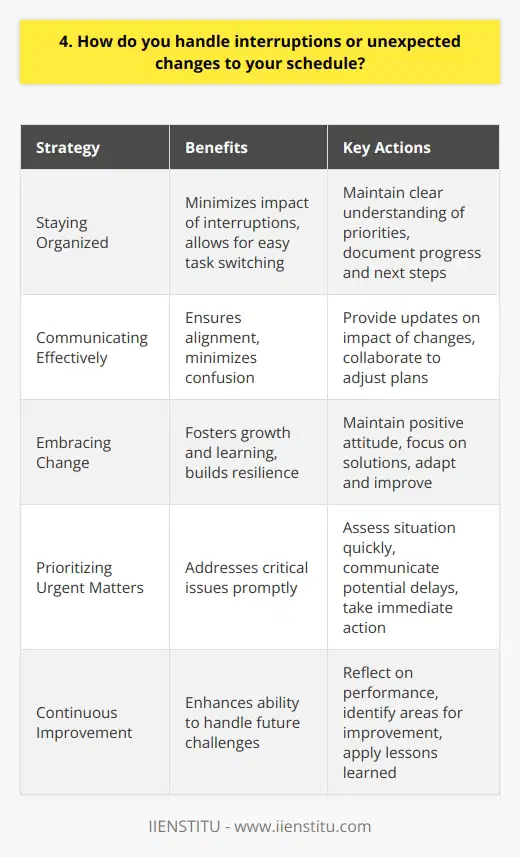
5. Can you give an example of how you've improved your time management skills?
Over the years, I've learned that effective time management is crucial for success in both personal and professional life. One of the most significant improvements I've made is prioritizing my tasks based on urgency and importance. By focusing on the most critical tasks first, I ensure that I make the best use of my time and energy.
Setting Clear Goals and Deadlines
Another strategy that has helped me improve my time management skills is setting clear goals and deadlines for myself. I break down larger projects into smaller, manageable tasks and assign realistic timelines to each one. This approach helps me stay organized and motivated, as I can see the progress I'm making towards my overall objectives.
Minimizing Distractions
I've also learned to minimize distractions and create a conducive environment for productivity. I turn off notifications on my phone and computer when working on important tasks, and I communicate my availability to colleagues and family members to avoid unnecessary interruptions. By doing so, I can maintain my focus and complete my work more efficiently.
Continuous Learning and Adaptation
Finally, I believe that improving time management skills is an ongoing process. I regularly reflect on my work habits and seek feedback from others to identify areas for improvement. I'm always open to learning new techniques and tools that can help me optimize my time and boost my productivity.
In summary, through prioritization, goal-setting, minimizing distractions, and continuous learning, I've significantly enhanced my time management abilities. These skills have not only made me more efficient at work but have also helped me maintain a healthier work-life balance.

6. How do you balance short-term tasks with long-term goals?
I strive to strike a healthy balance between focusing on urgent tasks and making steady progress toward bigger-picture objectives. It's not always easy, but I've developed some effective strategies over the years.<h3>Prioritize ruthlessly</h3><p>I'm pretty ruthless about prioritizing my workload. Every morning, I write down my top 3 must-dos for the day. These are the mission-critical, time-sensitive items that absolutely have to get done, even if nothing else does. I learned the hard way early in my career that if you don't prioritize, urgent tasks can totally derail you from important goals.<h4>Block time for deep work</h4>To make headway on long-term projects, I block off chunks of uninterrupted "deep work" time on my calendar, usually in 90-minute stretches. I treat these blocks as sacred and try to minimize distractions during them. It's amazing how much you can get done in a focused sprint! I'm at my best in the mornings so I frontload my deep work then.<h3>Measure and adjust constantly</h3>Balancing daily tasks with big goals is an ongoing juggling act. I'm always measuring my progress and adjusting as needed. If I spend a few days fighting fires, I know I need to carve out extra time for strategic projects the next week. It's a constant cycle of calibration, but worth the effort to keep things in balance. I'm certainly not perfect at it, but I'm always striving to optimize my approach.
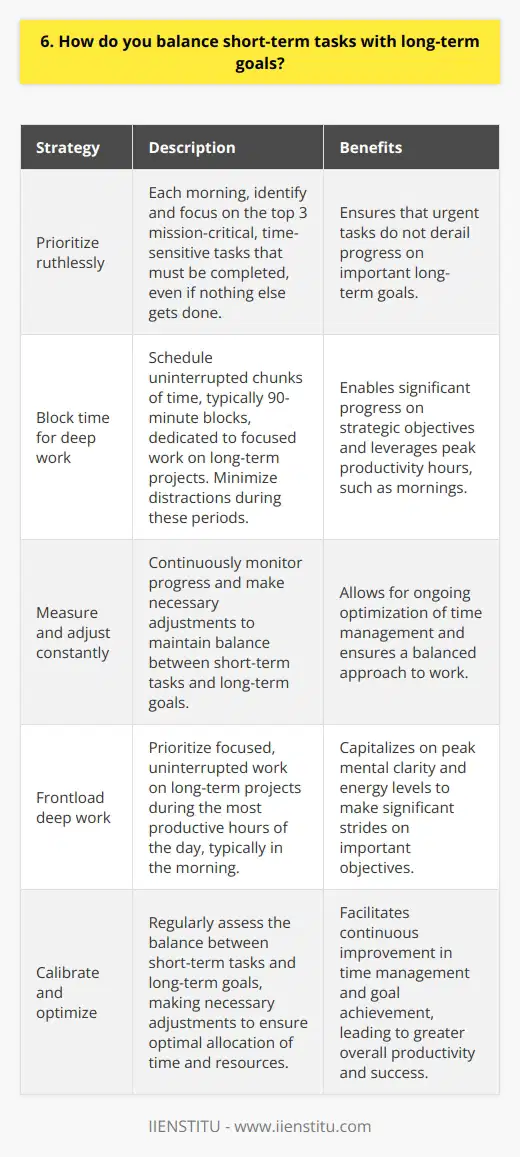
7. What tools or techniques do you use to manage your time effectively?
I've found that using a combination of digital tools and traditional methods helps me manage my time effectively. I rely on my calendar app to keep track of appointments, deadlines, and important events. This ensures I never miss a critical meeting or forget about a task that needs to be completed.
In addition to digital tools, I also use a physical planner to jot down my daily to-do list. There's something satisfying about crossing off tasks as I complete them throughout the day. It helps me stay focused and motivated.
Prioritizing Tasks
Another key aspect of my time management strategy is prioritizing tasks based on importance and urgency. I take a few minutes each morning to review my to-do list and identify the most critical items that need to be tackled first. This helps me avoid getting bogged down in less important tasks and ensures I'm making progress on my top priorities.
Taking Breaks
I've also learned the importance of taking regular breaks to recharge and avoid burnout. When I'm working on a big project, I use the Pomodoro Technique to break my work into focused 25-minute sessions followed by short breaks. This helps me stay energized and avoid getting overwhelmed by the task at hand.
By using a combination of digital tools, physical planners, prioritization, and regular breaks, I'm able to manage my time effectively and stay on top of my workload. It's an approach that has served me well in both my personal and professional life.
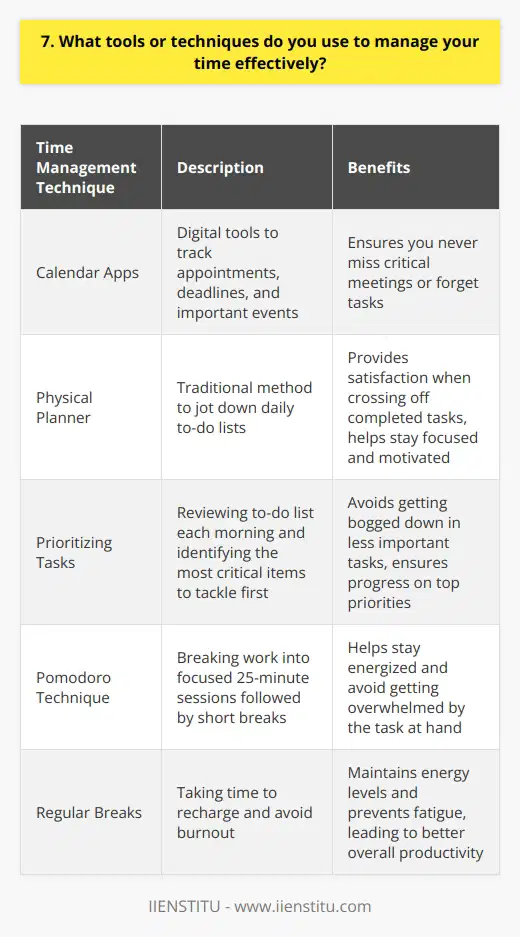
8. How do you decide what tasks to delegate or outsource?
When deciding which tasks to delegate or outsource, I consider several key factors. First and foremost, I evaluate the skills and expertise required for each task. If a task falls outside my core competencies or would be more efficiently handled by a specialist, I'm more likely to delegate or outsource it.
Time Management and Productivity
I also assess the impact on my time management and overall productivity. If a task is time-consuming but not the best use of my skills, delegating or outsourcing can free me up to focus on higher-priority responsibilities where I can add more value.
Cost-Benefit Analysis
Another important consideration is the cost-benefit analysis. I weigh the financial implications of handling a task in-house versus outsourcing. If outsourcing proves to be more cost-effective without compromising quality, it becomes a viable option.
Confidentiality and Control
However, I'm cautious about delegating or outsourcing tasks that involve sensitive information or require a high level of control. In such cases, I prefer to keep the work in-house to maintain confidentiality and ensure alignment with company standards.
Employee Development
Lastly, I consider the potential for employee development when deciding whether to delegate. If a task presents an opportunity for a team member to learn and grow, I may choose to delegate it internally, providing guidance and support as needed.
Ultimately, my decision to delegate or outsource is based on a careful assessment of each task's requirements, impact on productivity, cost-effectiveness, and alignment with company goals and employee development.

10. How do you ensure that you meet deadlines consistently?
I have a solid track record of consistently meeting deadlines through a combination of effective time management strategies and clear communication with my team and stakeholders.
Prioritizing and Planning
I start by carefully reviewing the requirements and due dates for each project or task assigned to me. Then, I break down the work into manageable steps and create a detailed timeline, allocating sufficient buffer time for unexpected challenges. By prioritizing my tasks based on urgency and importance, I ensure that I tackle the most critical items first.
Regular Check-Ins and Updates
Throughout the project, I maintain open lines of communication with my colleagues and managers. I provide regular status updates, highlighting my progress, any potential roadblocks, and the steps I'm taking to overcome them. This proactive approach allows me to identify and address issues early on, minimizing the risk of missing deadlines.
Collaboration and Delegation
I'm a strong believer in the power of collaboration. When faced with tight deadlines, I don't hesitate to reach out to my team members for support. By leveraging their expertise and delegating tasks appropriately, I can ensure that we collectively meet our goals on time.
Adaptability and Flexibility
In my experience, unforeseen challenges can sometimes arise, threatening to derail even the best-laid plans. That's why I remain adaptable and flexible in my approach. If I encounter an obstacle that could jeopardize a deadline, I quickly reassess the situation, explore alternative solutions, and communicate any necessary adjustments to my team and stakeholders.
By combining these strategies – prioritization, regular check-ins, collaboration, and adaptability – I have consistently demonstrated my ability to meet deadlines and deliver high-quality work, even under pressure.

11. What do you do when you realize you're falling behind schedule?
When I realize I'm falling behind schedule, the first thing I do is take a deep breath and assess the situation. It's important not to panic or get overwhelmed, as that can lead to even more delays. Instead, I try to identify the main reasons for the setback and prioritize the most critical tasks.
Communicate with the Team
If I'm working on a team project, I immediately communicate with my colleagues about the situation. By keeping everyone informed, we can collaborate to find solutions and adjust our plans accordingly. Open communication is key to ensuring that the entire team is on the same page and working towards the same goal.
Break Down Tasks
When time is limited, I break down larger tasks into smaller, more manageable ones. This helps me focus on what's essential and tackle the work in a more efficient manner. By setting smaller milestones, I can track my progress and feel a sense of accomplishment along the way, which keeps me motivated.
Seek Help and Delegate
If possible, I don't hesitate to ask for help or delegate tasks to other team members. Sometimes, a fresh perspective or an extra set of hands can make all the difference in getting back on track. It's important to recognize when you need assistance and be willing to accept it graciously.
Learn from the Experience
Finally, I always try to learn from the experience of falling behind schedule. I reflect on what caused the delays and consider how I can prevent similar situations in the future. By continuously improving my time management skills and adapting to unforeseen challenges, I become better equipped to handle tight deadlines and stay on track.
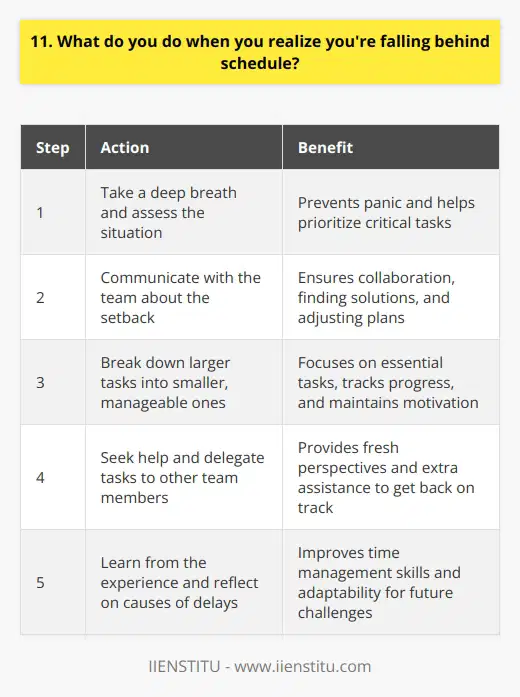
12. How do you manage your time when working on a team project?
When working on a team project, I believe effective time management is crucial. I always start by breaking down the project into smaller, manageable tasks and setting realistic deadlines for each one.
Prioritizing Tasks
I prioritize tasks based on their importance and urgency. This helps me focus on the most critical aspects of the project first. I also communicate regularly with my team members to ensure everyone is on the same page and aware of their responsibilities.
Using Time Management Tools
I find using time management tools like Trello or Asana really helpful. They allow me to create task lists, set reminders, and track progress. This way, I can stay organized and ensure nothing falls through the cracks.
Collaborating with Team Members
Collaboration is key when working on a team project. I make sure to schedule regular check-ins with my team members to discuss progress, brainstorm ideas, and address any challenges we may be facing. This helps us stay aligned and support each other throughout the project.
Staying Flexible
Of course, unexpected issues can always arise. That's why I try to stay flexible and adapt my time management strategies as needed. If a task is taking longer than expected or a team member needs extra support, I'm willing to adjust my schedule and priorities accordingly.
At the end of the day, effective time management is about being proactive, communicating clearly, and staying adaptable. By breaking down projects into smaller tasks, using helpful tools, collaborating with my team, and remaining flexible, I'm able to manage my time effectively and contribute to successful team projects.
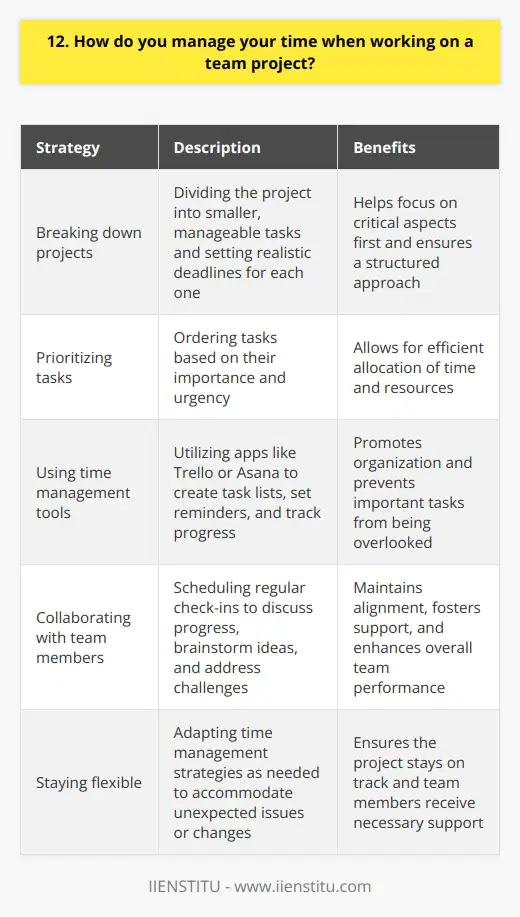
13. Can you describe a time when you had to juggle multiple projects simultaneously?
In my previous role as a project manager, I often faced the challenge of managing multiple projects simultaneously. One particular instance that comes to mind was when I was responsible for overseeing the development of three separate software applications, each with its own unique requirements and tight deadlines.
Prioritizing and Planning
To effectively juggle these projects, I first prioritized them based on their deadlines and importance. I created a detailed plan for each project, breaking them down into smaller, manageable tasks. This allowed me to allocate my time and resources efficiently.
Effective Communication
I maintained clear communication with my team members and stakeholders. Regular meetings and progress updates helped ensure everyone was on the same page. I also encouraged open dialogue to address any issues or concerns promptly.
Adaptability and Problem-Solving
Throughout the process, I encountered various challenges. When one project faced a technical setback, I quickly adapted my approach. I collaborated with the development team to find creative solutions and minimize the impact on the overall timeline.
Successful Outcome
By effectively prioritizing, communicating, and adapting, I successfully delivered all three projects on time and within budget. This experience taught me the importance of strong organizational skills, teamwork, and the ability to think on my feet when managing multiple projects simultaneously.
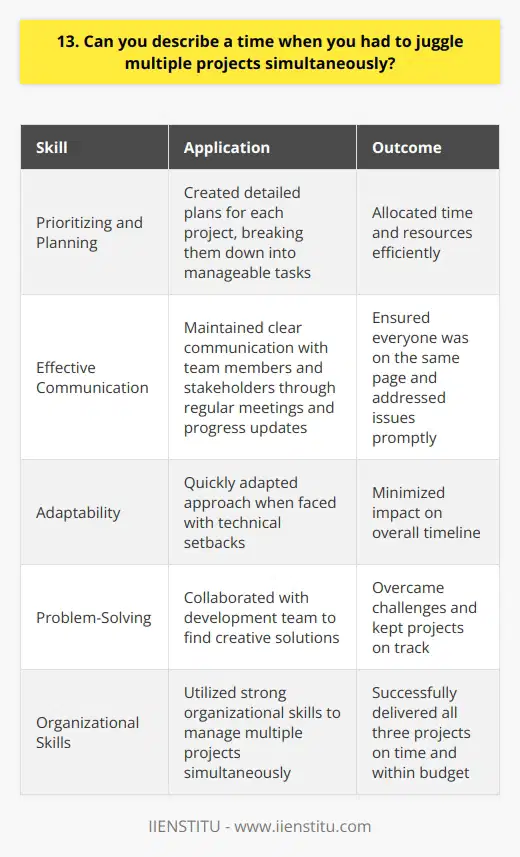
14. How do you handle procrastination or distractions?
I handle procrastination and distractions by breaking tasks into smaller, manageable steps. This helps me stay focused and motivated. I also set realistic deadlines for myself to ensure I stay on track.
Prioritizing Tasks
Another strategy I use is prioritizing my tasks based on urgency and importance. I tackle the most critical tasks first, which helps me avoid getting sidetracked by less crucial activities. I've found that creating a daily to-do list keeps me organized and accountable.
Minimizing Distractions
To minimize distractions, I create a conducive work environment. I turn off notifications on my phone and computer, and I let my colleagues know when I need uninterrupted focus time. If I'm working from home, I set up a dedicated workspace away from household distractions.
Taking Breaks
I also believe in the power of taking regular breaks to recharge and refocus. I step away from my desk, stretch, or take a quick walk to clear my mind. These short breaks help me maintain my productivity throughout the day.
Learning from Experience
Over time, I've learned to recognize my procrastination triggers and develop strategies to overcome them. For example, if I find myself repeatedly putting off a specific task, I examine why and look for ways to make it more manageable or engaging. I'm always looking for opportunities to improve my time management skills and stay on top of my workload.
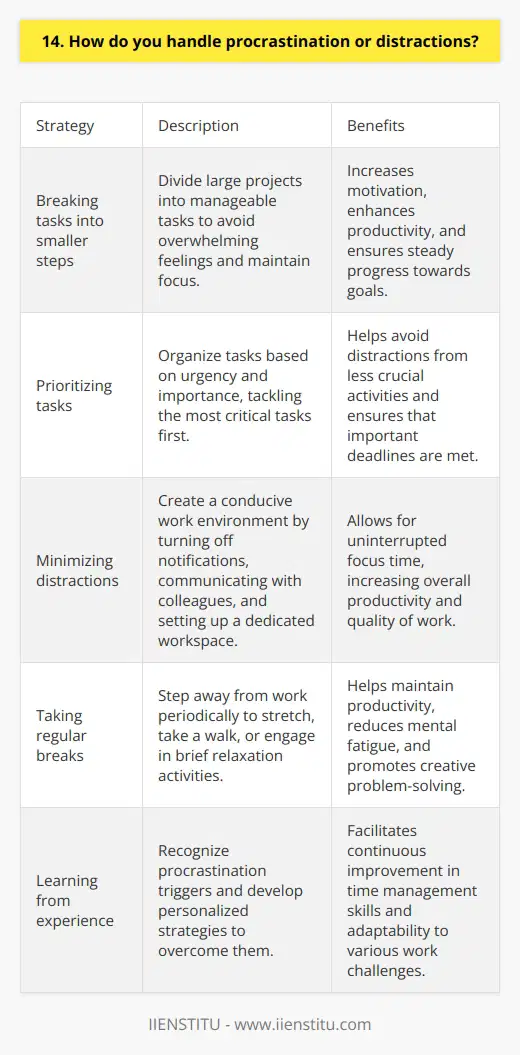
15. What's your approach to breaking down large tasks into manageable steps?
When faced with a large task, I first take a step back and assess the overall goal. This helps me understand the bigger picture and what needs to be accomplished. Next, I break the task down into smaller, manageable steps. By doing this, I can create a clear roadmap and timeline for completing the project.
Prioritizing and Delegating
Once I have a list of smaller tasks, I prioritize them based on importance and urgency. This allows me to focus on the most critical aspects of the project first. If working with a team, I also consider delegating tasks based on each team member's strengths and expertise. Collaboration is key to ensuring the project is completed efficiently and effectively.
Setting Milestones and Deadlines
To keep the project on track, I set milestones and deadlines for each smaller task. This helps me monitor progress and ensure that the project is moving forward as planned. I also build in some flexibility to account for unexpected challenges or setbacks that may arise.
Communicating and Adjusting
Throughout the project, I maintain open communication with my team and stakeholders. Regular check-ins and updates help keep everyone informed and aligned. If necessary, I'm also willing to adjust the plan based on feedback or changing circumstances. Adaptability is crucial when working on large, complex projects.
By breaking large tasks into smaller, manageable steps, prioritizing, setting deadlines, and communicating effectively, I'm able to tackle even the most challenging projects with confidence and success.

16. How do you communicate with your team or manager about your workload and deadlines?
I believe open communication is essential for managing workload and meeting deadlines effectively. I always strive to be proactive in keeping my manager and team informed about my progress and any challenges I'm facing.
Regular Check-Ins
I schedule regular check-ins with my manager to provide updates on projects and get their input. These meetings help ensure we're aligned on priorities and they're aware of what's on my plate. If my workload becomes overwhelming, I bring it up so we can work together to adjust timelines or reassign tasks as needed.
Collaboration Tools
I'm a big believer in using collaboration tools like Trello or Asana to manage projects transparently. I update task statuses and leave comments to keep everyone in the loop. These tools help my team understand what I'm working on and spot potential roadblocks early.
Honest and Timely Updates
If I foresee missing a deadline despite my best efforts, I communicate that to my manager right away. I explain the situation, propose solutions like reducing scope or getting help, and work with them to determine the best path forward. In my experience, managers always appreciate honesty and proactivity, even when delivering less-than-ideal news.
At the end of the day, I've found that frequent, transparent communication is key to successfully managing my workload and meeting the team's objectives. It's an approach that's served me well in my career thus far.
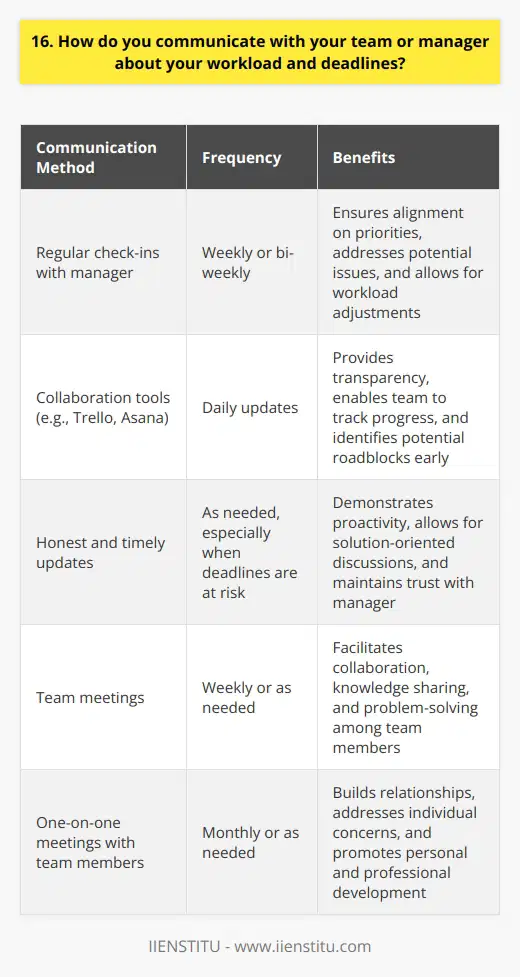
18. How do you ensure that you have enough time for important but non-urgent tasks?
Ensuring enough time for important but non-urgent tasks is crucial for long-term success and personal growth. Here are some strategies I use to make sure these tasks don't fall by the wayside:
Prioritize and Plan Ahead
I start each week by identifying my top priorities, both urgent and important. I block out dedicated time in my calendar for the important, non-urgent items like strategic planning, learning, and relationship building. Treating these tasks as unmovable appointments helps ensure they don't get pushed aside by the tyranny of the urgent.
Utilize Time Blocking
Time blocking has been a game-changer for me. I divide my day into focused blocks for specific activities. For example, I might set aside 9-11am for deep work on an important project, 2-3pm for meetings, and 4-5pm for responding to emails and tying up loose ends. Having a structured schedule keeps me on track.
Leverage Productivity Tools
I'm a big fan of productivity apps like Todoist and Evernote. They help me capture ideas, prioritize tasks, and stay organized. I do a weekly review to update my task list and make sure nothing important slips through the cracks. Technology is a great aid, but the key is developing a consistent system you can stick with.
Know When to Say No
Part of managing your time effectively is being judicious about what you take on. I've learned to politely decline invitations and requests that don't align with my priorities. It's about respecting your own time and boundaries. Saying no to the unimportant things frees up space for what really matters.
At the end of the day, making time for important, non-urgent tasks comes down to intention and discipline. It's a skill I'm always working to improve. I've found that when I'm proactive about tending to these items, I'm able to make meaningful progress on my long-term goals while still handling day-to-day responsibilities. It's a balancing act, but a worthwhile one.
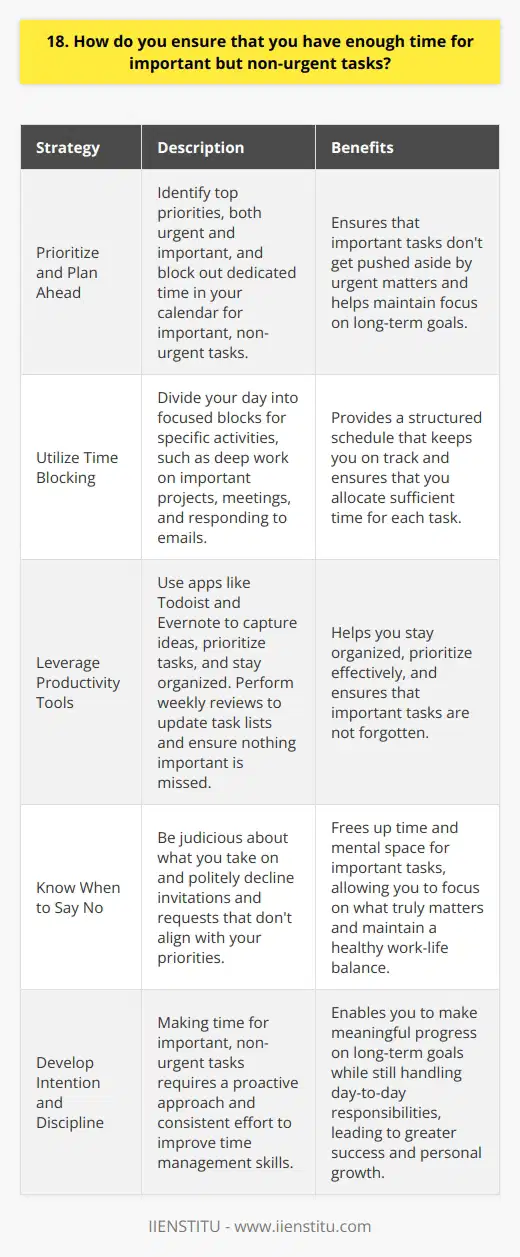
19. What do you do when you're facing a time management challenge that you haven't encountered before?
When faced with a new time management challenge, I first take a step back and assess the situation. I break down the task into smaller, manageable parts and prioritize them based on urgency and importance. This helps me create a clear plan of action.
Leveraging Technology
I'm a big believer in using technology to streamline processes and boost efficiency. I utilize tools like project management software, calendar apps, and automation whenever possible. These help me stay organized and on top of deadlines.
Collaborating with the Team
When I'm unsure about the best approach, I don't hesitate to reach out to my colleagues for guidance. Collaborating with the team allows me to tap into their expertise and get fresh perspectives. Together, we brainstorm creative solutions and divide tasks based on each person's strengths.
Staying Flexible and Adaptable
In my experience, unexpected obstacles are inevitable. That's why I stay flexible and ready to pivot when needed. If one strategy isn't working, I'm not afraid to try a different approach. Adaptability is key to overcoming time management challenges.
At the end of the day, I believe that effective time management is a skill that can be developed with practice. By staying organized, leveraging technology, collaborating with others, and remaining adaptable, I'm confident in my ability to tackle any new time management challenge that comes my way.
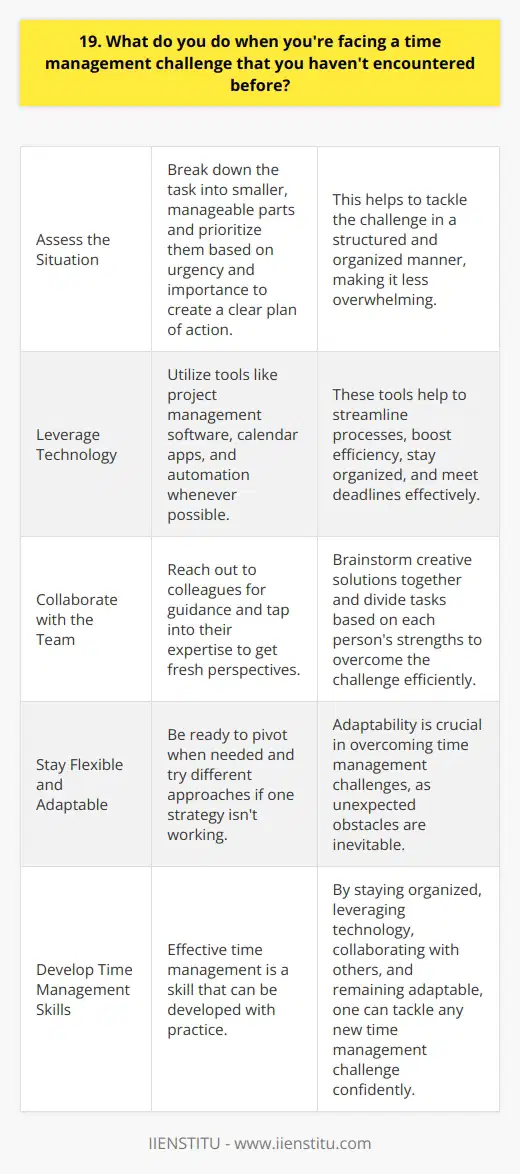
20. How do you manage your energy levels throughout the day to stay productive?
Maintaining high energy levels throughout the day is crucial for staying productive and focused. I've developed several strategies that help me manage my energy effectively.
Prioritizing Sleep and Rest
Getting enough quality sleep is the foundation of my energy management. I aim for 7-8 hours each night and stick to a consistent sleep schedule, even on weekends. Taking short breaks during the day to rest and recharge also helps me avoid burnout.
Eating for Energy
What I eat has a big impact on how I feel. I start my day with a balanced breakfast that includes protein, healthy fats, and complex carbs. Throughout the day, I choose nutrient-dense foods and snacks that provide stable energy. Staying hydrated by drinking plenty of water is also key.
Moving My Body
Exercise is a non-negotiable part of my daily routine. Whether it's a morning jog, lunchtime yoga class, or after-work strength training session, moving my body boosts my mood and energy. On especially busy days, even a 10-minute walk makes a difference.
Managing Stress
Stress is a huge energy drain, so I prioritize stress management. Deep breathing exercises, meditation, and talking through challenges with supportive colleagues help me stay calm and centered. I also set boundaries around my time and energy to prevent overcommitting myself.
Leveraging My Natural Rhythms
I've learned to work with, not against, my natural energy cycles. I tackle my most challenging tasks in the morning when I'm fresh and focused. After lunch, I shift to less intense work. Understanding my own rhythms allows me to be productive without burning out.
By being intentional about sleep, nutrition, movement, stress management, and aligning my schedule with my natural energy levels, I'm able to bring my best self to work each day. It's an ongoing process, but these strategies have made a meaningful difference in my productivity and well-being.

21. Can you describe a time when you had to adapt your time management strategy to a new situation?
I once had to adapt my time management strategy when I took on a new project at work. The project required me to collaborate with team members across different time zones, which meant I couldn't rely on my usual schedule.
Assessing the Situation
I quickly realized that I needed to be more flexible with my working hours. I also had to find ways to communicate effectively with my colleagues despite the time differences.
Adapting My Strategy
To tackle this challenge, I started by prioritizing my tasks based on urgency and importance. I made sure to complete critical tasks that required collaboration with my team members first.
Next, I used project management tools to keep track of deadlines and milestones. These tools helped me stay organized and ensured that everyone was on the same page.
I also made an effort to be available during the overlap hours when most of my team members were online. This meant adjusting my schedule and working slightly different hours than I was used to.
Communicating Effectively
To maintain clear communication, I relied heavily on video calls and instant messaging. I made sure to over-communicate and provide regular updates to keep everyone informed about my progress.
When scheduling meetings, I was mindful of my team members' time zones and tried to find times that worked well for everyone. If that wasn't possible, I made sure to send detailed meeting notes and action items afterwards.
The Result
By adapting my time management strategy and being proactive in my communication, I was able to successfully collaborate with my team members and complete the project on time. This experience taught me the importance of being flexible and finding creative solutions to manage my time effectively in new situations.

22. How do you handle time management when working remotely or with flexible hours?
I've developed a strong system for managing my time effectively while working remotely or with flexible hours. Here are some key strategies I use:
Establish a Consistent Routine
I find that sticking to a regular schedule helps me stay focused and productive. I typically start work at the same time each day, take breaks at scheduled intervals, and "clock out" when my workday is done. This routine provides structure and normalcy, even when I'm not in an office.
Prioritize and Plan Tasks
Every morning, I review my to-do list and prioritize the most important and time-sensitive items. I block off chunks of time on my calendar for focused work on high-priority projects. This ensures the essential tasks always get done, even with the flexibility of working remotely.
Minimize Distractions
It's easy to get sidetracked by household chores or other interruptions when working from home. To avoid this, I set up a dedicated workspace away from high-traffic areas. I let my family know my working hours so they know not to disturb me. Putting my phone on silent also prevents distracting notifications.
Take Advantage of Productivity Tools
I rely on digital tools like task management apps, time trackers, and shared calendars to stay organized and connected with my team. These tools provide visibility into everyone's schedules and workloads. They also help me track my time and progress toward goals.
Communicate Proactively
Working remotely requires extra effort to stay in sync with colleagues. I make it a priority to communicate regularly - sharing status updates, asking questions, and highlighting any roadblocks. Frequent communication ensures nothing falls through the cracks, even without the convenience of in-person conversations.
With these strategies, I'm able to manage my time efficiently and be a highly productive member of a remote or flexible team. I'm confident my organizational skills and self-discipline would enable me to thrive in this role's flexible work environment.

23. What do you do to avoid burnout when facing a heavy workload?
I have developed several strategies to maintain a healthy work-life balance and prevent burnout. First, I prioritize my tasks and focus on the most critical ones. This helps me manage my time effectively and reduces stress.
Setting Boundaries
I also set clear boundaries between work and personal life. When I'm not at the office, I disconnect from work-related matters and engage in hobbies and activities that recharge me. Spending quality time with family and friends is a priority for me.
Practicing Mindfulness
Mindfulness techniques like meditation and deep breathing exercises have been game-changers for me. They help me stay centered and calm even during hectic periods at work. I try to incorporate short mindfulness breaks throughout my day.
Staying Organized
Keeping my workspace tidy and organized reduces mental clutter and boosts my productivity. I use tools like calendars, to-do lists, and project management apps to stay on top of my tasks and deadlines.
Communicating with the Team
Open communication with my colleagues and supervisors is key. When I feel overwhelmed, I reach out for support and collaborate with my team to find solutions. We work together to distribute the workload fairly and efficiently.
By implementing these strategies consistently, I've been able to maintain a healthy work-life balance and deliver high-quality work even during demanding periods.
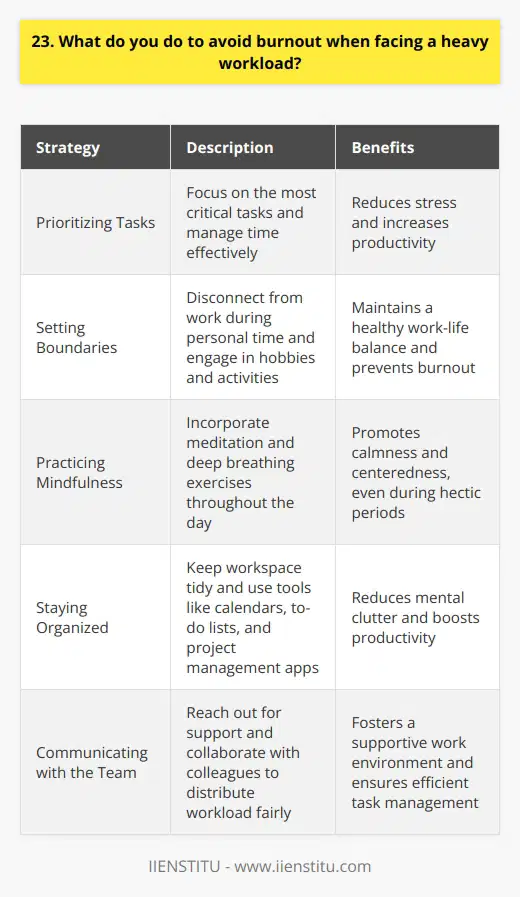
24. How do you prioritize self-care and work-life balance while managing your time?
Prioritizing self-care and maintaining a healthy work-life balance is crucial for my overall well-being and productivity. I believe that taking care of myself physically, mentally, and emotionally enables me to perform at my best both professionally and personally.
Setting Boundaries and Realistic Expectations
One key strategy I employ is setting clear boundaries between work and personal life. When I'm at work, I focus fully on my job responsibilities, but when I'm off the clock, I make a conscious effort to disconnect and engage in activities that recharge me. I've learned that setting realistic expectations for myself is essential – I strive to give my all while at work, but I also recognize that there are limits to what I can accomplish in a day.
Prioritizing Tasks and Using Time Management Techniques
To manage my time effectively, I prioritize my tasks based on urgency and importance. I use tools like to-do lists and calendars to keep myself organized and on track. I also break larger projects into smaller, manageable steps to avoid feeling overwhelmed. When I have multiple competing deadlines, I communicate openly with my team and supervisor to ensure everyone is on the same page and to discuss any necessary adjustments to timelines or workload distribution.
Making Time for Self-Care and Hobbies
Outside of work, I make a point to engage in activities that bring me joy and help me recharge. For me, that includes hobbies like hiking, reading, and spending quality time with loved ones. I've found that when I neglect my personal interests and relationships, my work performance and overall happiness suffer. By intentionally carving out time for self-care, I'm able to show up as my best self both at work and in my personal life.
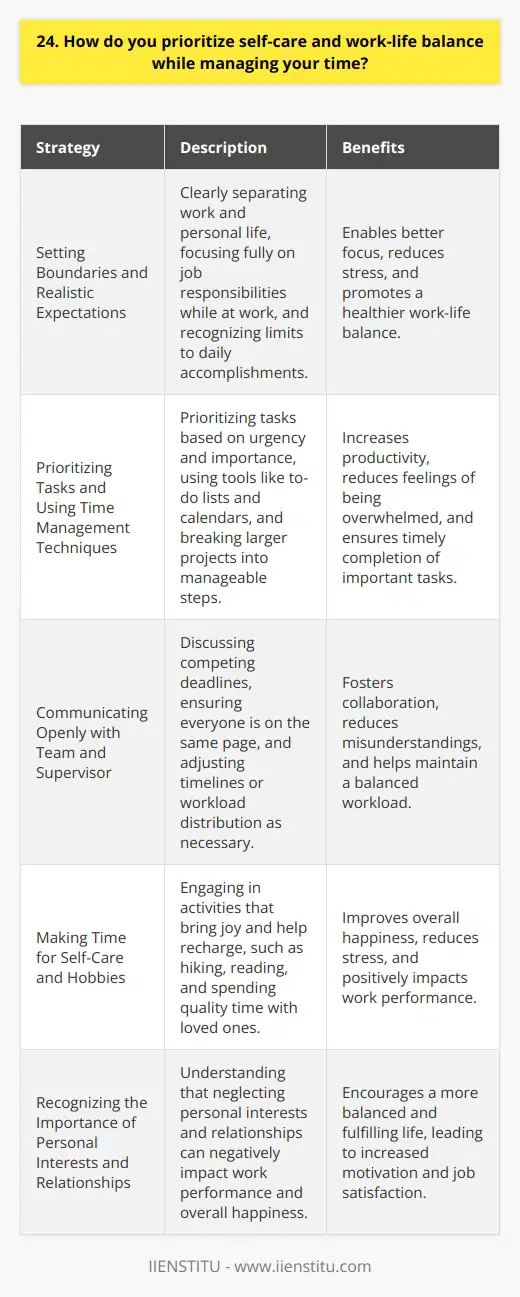
26. How do you manage your time when you have to attend meetings or training sessions?
I'm very proactive when it comes to managing my time, especially when I have meetings or training sessions scheduled. I always make sure to review my calendar at the start of each week and day, so I know exactly what's coming up. This helps me plan my work accordingly and ensure I don't overbook myself.
Prioritizing Tasks
When I see a meeting or training on my agenda, I look at my to-do list and prioritize the most important and time-sensitive items. I try to tackle a few key tasks before the meeting so I can give it my full attention without stressing about unfinished work. If needed, I'll block off extra time before or after the meeting to wrap things up or review my notes.
Communicating with My Team
Communication is key! I make sure my team knows when I'll be unavailable and who to contact if anything urgent comes up. I also set clear expectations about deliverables and due dates.
Staying Focused & Avoiding Distractions
During meetings and trainings, I stay engaged by taking notes, asking questions, and participating in discussions. Putting my phone away and closing irrelevant tabs helps me avoid distractions. If I think of an important task during the session, I'll jot it down to follow up on later rather than trying to multitask.
Debriefing & Applying What I Learned
Afterwards, I take a few minutes to debrief - identifying key takeaways, action items, and anything I'm unsure about. I'll schedule time to apply what I learned or complete necessary follow-up tasks. And I always aim to provide feedback to the organizer about what I found valuable and any suggestions for improvement.

27. What do you do to stay motivated when working on a long-term project?
When working on a long-term project, staying motivated is crucial for me. I have a few strategies that help me maintain my focus and drive.
Set Clear Goals and Milestones
I break down the project into smaller, achievable goals. This way, I can celebrate small wins along the way and feel a sense of progress. Seeing how far I've come keeps me motivated to keep pushing forward.
Find Inspiration in the Bigger Picture
I remind myself of the project's purpose and the impact it will have. When I feel connected to the larger vision, it's easier to stay motivated through the day-to-day challenges. I imagine how proud I'll feel when the project is complete.
Take Breaks and Recharge
I've learned that taking regular breaks is essential for my motivation and productivity. When I step away from the work, even for a few minutes, I come back with fresh eyes and renewed energy. I like to take a quick walk outside or chat with a colleague to recharge.
Collaborate and Communicate
I find that collaborating with my team and communicating regularly helps me stay engaged. When we share ideas and support each other, it's easier to stay motivated. We celebrate our progress together and help each other through the tough spots.
Staying motivated on a long-term project takes effort, but it's so rewarding to see it through to completion. These strategies have helped me stay focused and driven, even when the finish line seems far away.
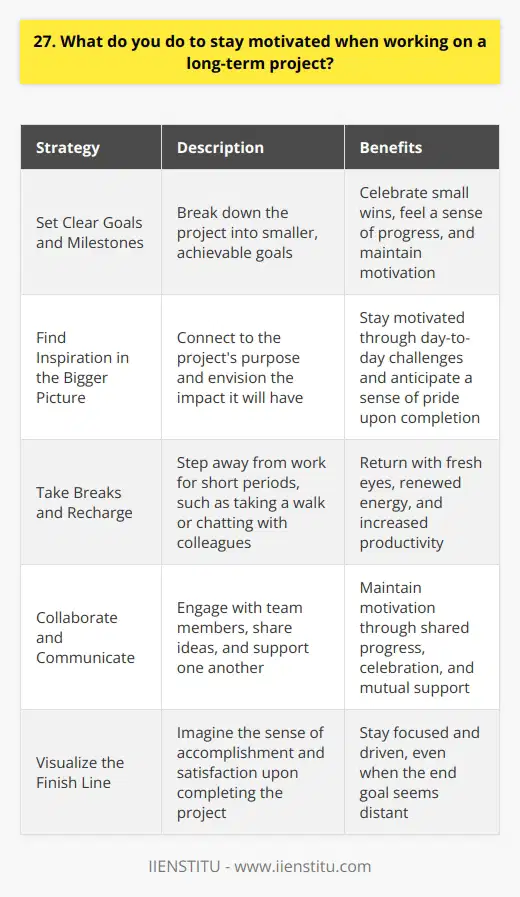
28. How do you handle time management when you're working in a fast-paced environment?
When faced with a fast-paced work environment, I prioritize tasks based on urgency and importance. I create a daily to-do list and allocate specific time slots for each task.
Effective Communication
I maintain open lines of communication with my team members and supervisors. This helps me stay informed about changing priorities and adjust my schedule accordingly.
For example, in my previous role at a busy marketing agency, I regularly checked in with my project manager to ensure I was focusing on the most critical tasks.
Flexibility and Adaptability
I understand that in a fast-paced environment, priorities can shift quickly. I remain flexible and adaptable, ready to pivot when necessary.
I once had to put a project on hold to assist with an urgent client request. By being flexible, I helped our team meet the tight deadline and exceed the client's expectations.
Time-Saving Techniques
I use various time-saving techniques to maximize my productivity. These include:
Continuous Improvement
I believe in continuously improving my time management skills. I reflect on my successes and challenges, seeking ways to optimize my approach.
By staying organized, communicating effectively, and remaining adaptable, I ensure that I can manage my time well in fast-paced environments while delivering high-quality work.
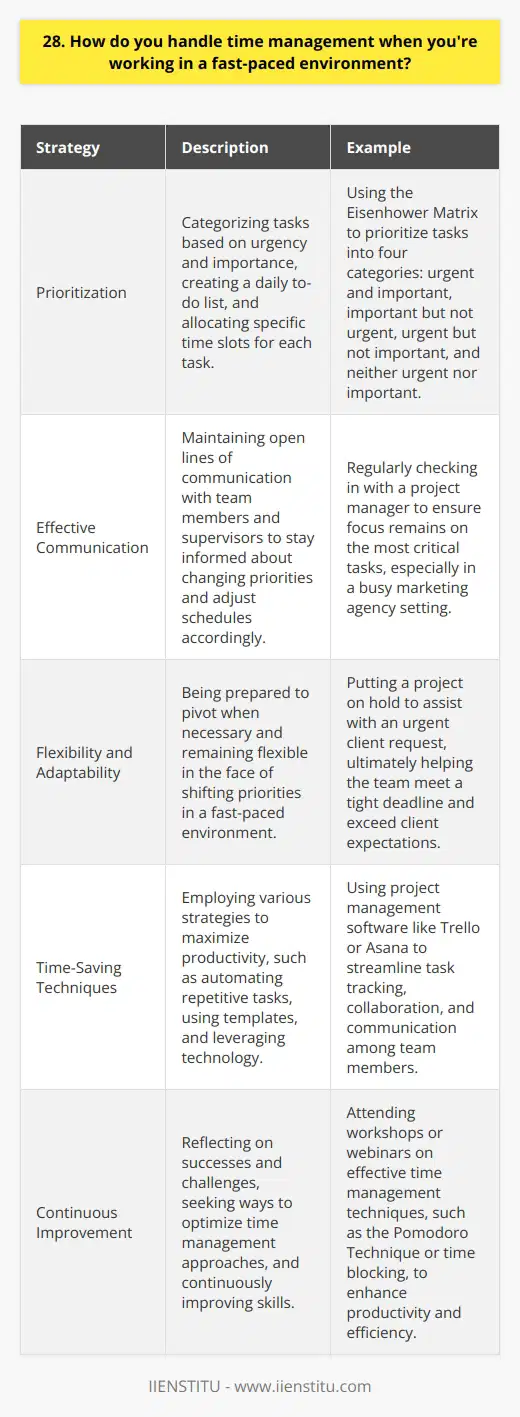
29. Can you describe a time when you had to prioritize tasks based on their impact or value?
In my previous role as a project manager, I often had to prioritize tasks based on their impact and value. One specific instance that comes to mind was when we were working on a tight deadline for a client's website launch.
Assessing the Situation
I took a step back and assessed the situation. There were multiple tasks to complete, but not all of them were equally important. Some tasks, like ensuring the website's functionality and user experience, were crucial for the launch's success.
Prioritizing High-Impact Tasks
I prioritized the tasks that would have the highest impact on the website's performance and user satisfaction. This included tasks like optimizing page load speed, fixing bugs, and ensuring mobile responsiveness. These tasks were given the highest priority because they directly affected the website's core functionality and user experience.
Delegating and Collaborating
I delegated tasks to team members based on their skills and expertise. We worked collaboratively, with regular check-ins and updates. This ensured that everyone was on the same page and working towards the common goal of a successful website launch.
Adjusting and Adapting
As the project progressed, I continually reassessed the priorities and made adjustments as needed. If new issues arose or priorities shifted, I adapted the task list and communicated the changes to the team.
By prioritizing tasks based on their impact and value, we were able to successfully launch the website on time. The client was thrilled with the result, and it strengthened our relationship with them. This experience taught me the importance of effective task prioritization and collaboration in achieving project success.
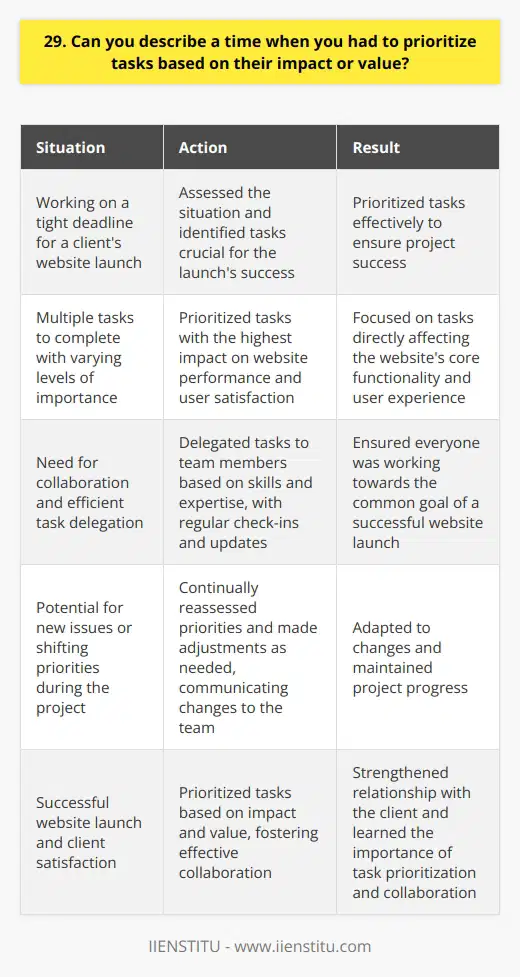
30. How do you ensure that you're using your time efficiently and effectively?
I ensure that I'm using my time efficiently and effectively through a combination of strategies. First and foremost, I prioritize my tasks based on their importance and urgency. This helps me focus on the most critical tasks first.
Planning and Scheduling
I create a daily schedule that allocates specific time blocks for different activities. This helps me stay organized and avoid wasting time on unimportant tasks. I also set realistic deadlines for myself and strive to meet them consistently.
Minimizing Distractions
To maintain focus, I minimize distractions by turning off notifications on my devices and finding a quiet workspace. When I need to concentrate deeply, I put on noise-canceling headphones and listen to instrumental music.
Taking Breaks
I've learned that taking short breaks throughout the day actually boosts my productivity. Stepping away from my desk for a few minutes helps me recharge and return to my tasks with renewed energy and focus.
Continuous Learning and Improvement
I'm always looking for ways to improve my time management skills. I attend workshops, read books, and seek advice from colleagues who are particularly efficient. By continuously learning and adapting, I'm able to refine my strategies and become more effective over time.
In my experience, the key to using time efficiently and effectively is finding a system that works for you personally. It's taken me some trial and error, but I've developed a routine that helps me stay on track and achieve my goals consistently.
